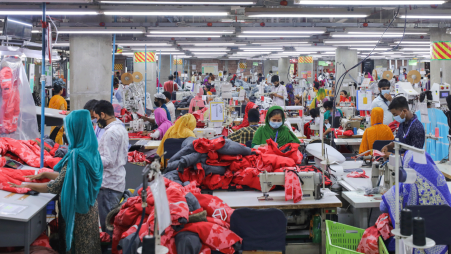Bangladesh RMG sector eyes major gains as US slaps high tariffs on India
To capitalise on this opportunity, they called for urgent govt steps to resolve the gas crisis in the industrial sector

Highlights
- US imposes a 50% reciprocal tariff on Indian goods
- Tariffs on Chinese imports at 30%, Trump hinted at further hike
- US buyers could save up to 30% by sourcing from Bangladesh
- Bangladesh eyes rising investment from China and India
- Steady industrial gas supply key to attracting investment
- Vietnam also set to gain from US orders with lower 20% tariff
Bangladesh's apparel exporters view the 50% US tariff on Indian goods as an opportunity for the country to increase its garment exports, while also attracting investments from India and China.
To capitalise on this opportunity, they are calling for urgent steps to resolve the gas crisis in the industrial sector. They also emphasised the importance of political stability, improved port operations, a more favourable investment climate, and reforms in the banking sector.
The US imposed a 25% reciprocal tariff on Indian goods last week and plans to impose another 25% if India continues its energy imports from Russia. The additional tariff is set to take effect on 27 August and is expected to impact India's $87 billion worth of exports to the US.
The US tariff on Chinese products now stands at 30%, while negotiations between the two countries are underway. On Wednesday, Trump said he might increase the tariff further.
According to exporters, this shift is likely to divert more orders to Bangladesh and Vietnam, while also opening the door for increased investment from China and India.
China remains the top exporter of ready-made garments to the US and global markets, followed by Bangladesh, Vietnam, and India.
The US has already imposed a 20% reciprocal tariff on apparel imports from both Bangladesh and Vietnam. As a result, even if other costs remain unchanged, US buyers could cut costs by nearly 30% simply by sourcing the same garments from Bangladesh instead of China or India.
Besides Bangladesh and Vietnam, countries like Pakistan, Indonesia, and Turkey also export garments at similar tariff rates.
However, exporters say these countries lack the production capacity to ramp up exports significantly. This is why they expect US buyers to increasingly turn to Bangladesh and Vietnam to fill the gap.
Mahmudul Hasan Babu, president of the Bangladesh Garment Manufacturers and Exporters Association (BGMEA), told TBS that if the existing additional US tariffs on India and China remain in place, there is a significant opportunity for Bangladesh to receive increased export orders and investment from these countries.
However, due to the ongoing gas crisis, the country's backward linkage textile sector is unable to fully utilise its production capacity, he said.
"To take advantage of the export and investment opportunities now emerging, gas supply to the textile sector must be increased immediately to enable production at full capacity," the BGMEA president said.
"We must also strengthen our backward linkage and supply chain. Relying heavily on imported fabric and yarn will not allow for substantial export growth," Hasan Babu added.
Mohammad Hatem, president of the Bangladesh Knitwear Manufacturers and Exporters Association (BKMEA), echoed Babu.
He explained that the higher tariffs will reduce apparel exports from China and India, creating a supply gap in the US market that only Bangladesh and Vietnam can fill.
"This presents a major export opportunity for us, but how well we can capitalise on it depends on certain government decisions," Hatem said.
To fully seize this opportunity for export and investment, he said Bangladesh must resolve the gas crisis, speed up operations at ports, and address the ongoing financing issues in the banking sector.
Former BGMEA president and current President of the Bangladesh Chamber of Industries, Anwar-Ul-Alam Chowdhury Parvez, told TBS that India primarily exports T-shirts, as well as fancy and highly designed women's apparel. Their exports are mainly in the mid- to high-price segments.
He said that Indian T-shirts often feature embossed designs and decorative beads, while the types of women's garments India produces are not typically made in Bangladesh. "We mostly export high volumes of low-priced garments, whereas India exports smaller volumes of higher-end products," he said.
Parvez said, "Since buyers will be less inclined to import from India and China due to the higher duties on their products, there's now an opportunity for investment to shift from those countries to Bangladesh."
To bank on this opportunity, Parvez said Bangladesh must act swiftly. "The extent to which we can attract foreign investment will depend on what kind of support the government offers to investors, the structure of tariffs and taxes, and how much bureaucratic complexity can be reduced in the investment process."
Commenting on the broader implications of the US-imposed tariffs, Parvez said these moves are creating a new geopolitical dynamic.
He believes countries like India, China, Russia, and other BRICS members may begin to align against the United States. Given this context, he suggested the Bangladesh government should start studying how global trade patterns might shift in the coming days.



 Keep updated, follow The Business Standard's Google news channel
Keep updated, follow The Business Standard's Google news channel















